Healing Minds Foundation’s Growth
Broad objective of the project
The success of trauma helplines has been well-documented globally. After extensive research we recognised that there are two main problems facing those who have been psychologically damaged by the seemingly intractable violence in Kashmir. The first is the profound social stigma in Kashmir attached to going to a psychiatric hospital or clinic. For example, if a young village woman is known to have been to a psychiatric clinic it will be seen as a stain on her personality, and her marriage chances, regardless of how temporary her psychological problem may be. A helpline staffed by highly trained listeners addresses this problem because it offers anonymity and total confidentiality. This is particularly powerful in a society where it is hard for people to be able to speak in private about the emotional and mental problems that they are facing.
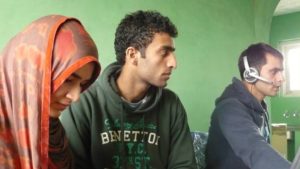
Kashmir LifeLine listening staff during training. Photo © Barbara Krieger
This project is also targeting a sector of Kashmiri youth that feels disenfranchised and disempowered by the situation in the state. One of the fundamental issues is that these young people do not feel that they are being heard, and therefore, in some cases, they resort to violence, as has been witnessed during intense periods of civil unrest in Kashmir in recent years. A helpline that allows callers to talk, and that guides them towards examining their frustrations and fears, has been proven one of the most effective ways of breaking through to this youth sector. Our project emphasises this by use of multi-media options, giving callers the options of live on-line chat, and email, as well as being able to call the toll-free number. In addition to this the caller is given the option of coming to our mental health centre for further treatment, if required, or to one of our outreach centres. If it is not possible for them to get to the centre we have a well-researched referral network.
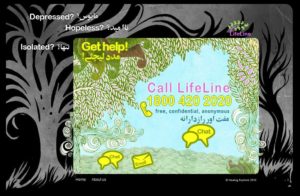
The homepage for Kashmir LifeLine. http://kashmirlifeline.org Designed by Imobisoft.
As a tool of referral the helpline offers this network to callers. Information about medical and mental health facilities is very limited in Kashmir. We have created a system of Social Resource Mapping (SRM) that collates information on hospitals, clinics, primary health centres, de-addiction centres, NGOs and their services, and other support organisations. Our team of listeners has been trained to use this referral system when speaking to callers. As a part of the Social Resource Mapping we continue to do liaison work with those on the list in order to keep information up to date, and to check that referrals are being seen, and treated.
We are very conscious of the fact that the ‘burn-out’ rate amongst mental health workers in Kashmir is high. We have put a premium on training our staff to understand how the work impacts them personally. We have trained them in methods of self-awareness, self-analysis, and physical and mental relaxation techniques. All of our senior staff are already experienced counselors, with a minimum of two years work in the field in Kashmir.
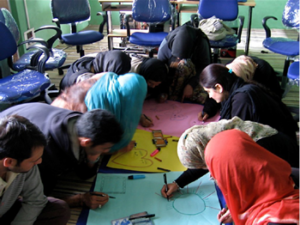
Using art as one method of self-analysis for listeners
The second major problem is the one of time, or rather the lack of it. A patient has roughly two or three minutes with a psychiatrist in an out patients’ clinic. This only allows time to prescribe medication at high speed. The pressure on doctors and psychiatrists is enormous, and they have no option but to work this way. Our mental health centre works on an appointment basis that allows a minimum of an hour per patient, offering a combination of counseling, mental trauma therapy, and medication advice.
Our helpline office and mental health centre opened in January 2011. We ran the first training course for our listeners in January and February 2011, and we now have a very impressive and motivated team of young Kashmiri men and women, trained to be both listeners and counselors. In addition to this we have a management team in place, headed by our senior doctor. Our centre is located within the Civil Lines area of Srinagar, so that it can still be accessed, even during full curfews in the city. It is also close to a main bus stand so that it is easy for patients and staff to reach. We have chosen a quiet area so that it is a peaceful and unthreatening environment for both our staff, and for patients coming to the centre, particularly those from village and rural areas who are not used to the chaos of the city.
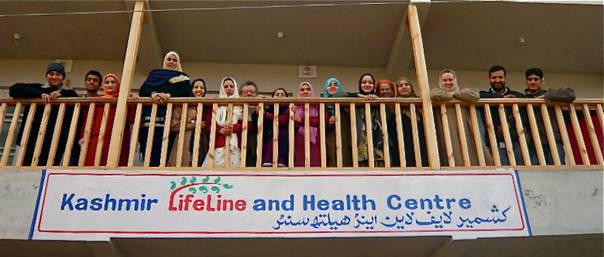
Kashmir LifeLine and Health Centre staff on the balcony of our premises
To sum up recent progress we now have a very punchy three tier-system in place: the suicide and mental trauma helpline is the top layer, and the phones are ringing all the time. Callers can speak to a listener for as long as they need. This also acts as a referral system to our next tier: our main mental health centre, or to one of our five outreach centres around the rest of the state, situated in some of the worst-affected areas. People coming for appointments have a minimum of one hour with a therapist or counselor, as against the maximum of the three minutes face time that was referred to earlier. The third tier is a broad-based awareness programme. We are training the local network of female primary health care workers (Anganwadi workers) across the state so that they can give basic mental health care within the community, and be a referral system to our centres.
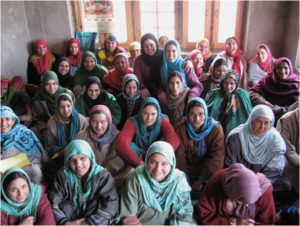
Nazima and Peer Nazia, (centre back) of our team with an Angawadi group at the end of a training session.
We have also been running mental health awareness programmes in schools, colleges and with government health and social services agencies. In addition we have recently launched a weekly radio programme, a question and answer series on one of the most popular stations. This is because it is hard to reach women, except through the female primary health care worker system, or via popular radio. The idea is that listeners get involved in the programme, and learn about mental health at the same time. Radio is a better option than television because the power goes out so often that radio has a higher listenership than television viewing figures.
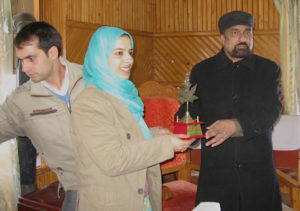
Two of our senior team, Fairoz and Nazia Ronga, receiving a government award for the work of Kashmir Lifeline in the region.
The main thing to know about the project, at this stage of its evolution, is that we focus on allowing people to understand why they are in the psychological pain and distress; why this happens as a result of conflict; and to re-empower them to take responsibility again for their lives, and those of their families. To us, it makes more sense to rebuild societies in conflict, post conflict, or in the aftermath of natural disasters, in this way, from the inside out, rather than emasculating them by making them dependent on aid and external support.
Healing Minds Foundation also currently has under-graduate and post-graduate internship programmes running with Tufts University (Boston, USA), Sarah Lawrence College (New York), Wilson College (Mumbai), and The Oslo Freedom Forum’s Oslo Scholars Programme
To date the project has been made possible due to the support, work, advice and energy of the following people: Malik Sajad, illustrator and cartoonist, who designed and created our website in conjunction with Barbara and Imobisoft, Srinagar, Dr Arshad Hussain – senior psychiatrist, Srinagar, and one of our advisors, And we are all grateful to the generosity and warmth of our private donors:
- Marie Lippens
- Natasha Kumar
- Kate and Denzil How
- Laila Embelton
- Jean and Denis Clack
- Louise Grime
- Ariane Lang and her yoga students
- Tracey Jackson
- Richard I. Morris Jr.
- Steven Cohen and Andréa MacLeod
- and Beth Floor
My particular thanks go to Barbara Krieger and Richard Morris whose energy and drive are two of the most valuable assets that this project has.
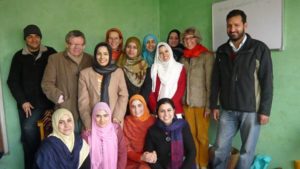
Richard and Barbara, second from left, and second from right, with the team
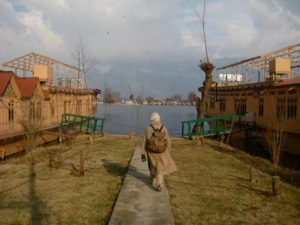
At the end of the day. Photo © Jonathan Foreman
Copyright © 2011 and 2012 Justine Hardy
info@www.justinehardy.com
